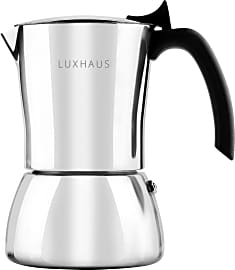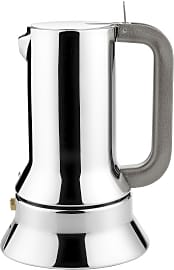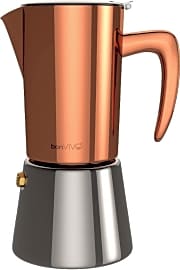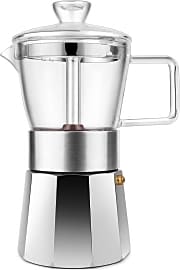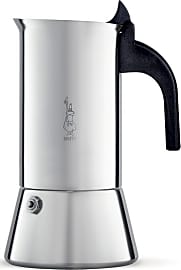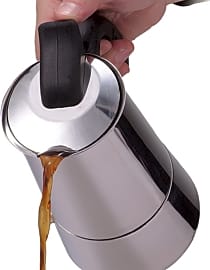The 9 Best Stovetop Espresso Makers

This wiki has been updated 40 times since it was first published in June of 2015. You can get your caffeine fix without having to head to the local cafe and shelling out a small fortune every day. Also called moka pots, these espresso makers provide a cheap and easy way to get a good cup of the strong stuff whenever you want it in the comfort of your own home. Just add your favorite ground beans and some water, and you'll be happily sipping java in no time. When users buy our independently chosen editorial recommendations, we may earn commissions to help fund the Wiki.
Editor's Notes
July 15, 2021:
Technically known as moka pots, these stovetop coffee makers deliver a brew that's nearly as strong as what you'd get from a cafe, even if it doesn't have the signature crema. At any rate, the only change made this time around was removing a poorly performing model that tried and mostly failed to emulate the Bialetti Express, which is an easy winner due to its consistent construction quality and angled sides that make it easier to open. It also comes in a range of sizes, allowing you to make enough coffee to keep everybody up all night.
August 05, 2020:
Before we head into the changes we made during today's update, we wanted to make it clear that while Moka pots like the ones you'll find here are known interchangeably as "stovetop espresso makers" due to their similar brewing techniques, they do not yield true espresso, which requires more pressure than a stovetop maker can produce. What you get instead is an espresso-like coffee that is intense, heavy-bodied, and suitable for making faux americanos and cappuccinos should you wish, but sadly without crema.
Because traditional espresso machines tend to be extremely pricey, the Moka pot is an excellent alternative for those who want similar results without breaking the bank.
Today we said goodbye to the Alpha Coffee, which became unavailable, and the MateoJo Italian, which we felt was close enough in price and design to the Vremi Demitasse to allow us to let it go for a more compelling option. That selection is the Geesta Premium, an elegant unit that lets you watch the brew process and takes the guesswork out of whether or not your coffee is done. Obviously, being glass, you need to be careful cleaning and handling it, but many users feel the trade-off for such an attractive, functional piece is worth it.
We also brought on the LuxHaus Moka, a sleek, straightforward device that offers solid quality at an affordable price. It's sandblasted instead of treated with chemical cleaners and is sturdy enough to work admirably as a daily brewer.
May 29, 2019:
If you're looking for an authentic Italian model, the Bialetti Express is a hugely popular option that comes in five sizes ranging from one to twelve cups, and it's easy to disassemble and clean. The Cuisinox Roma is both elegant and functional, and it's handcrafted from heavy-gauge stainless steel, which will last for years. The largest model has a 10-cup capacity, but the included reducer allows you to make a smaller amount if you wish. The Alessi 9090 is tiny, but very well-made, and its 18/10 stainless steel body and cast iron handle are extremely durable. But, at such a premium cost, it's probably too expensive for most casual coffee drinkers.
Both the Alpha Coffee and Grosche Milano are affordably priced, and the latter comes in four finishes with heat-resistant burn guard handles to protect your fingers. With its budget-friendly price tag, the Vremi Demitasse is a good choice for those who want to test the waters of stovetop brewing without spending too much, or if you just need something you can toss in your bag to take along on camping trips. But it tends to pour rather messily and is not as durable as higher-end pots, so it's not the best option if you plan on using it several times a day.
Special Honors
Bacchi Carioca Crafted in Italy, the professional-grade Bacchi Carioca is a patented stovetop system capable of reaching the traditional 8-9 bar pressure and 85-90 degree temperature that results in crema, something many Moka pots are unable to do. It's straightforward to use, whistles when it's ready, and is made from anodized aluminum that renders it corrosion and scratch-resistant. 1stline.com
It’s Easier To Drink Espresso With Your Nose Turned Up
Ultimately, you can fall back on the argument that it’s all a matter of taste, but that often cedes the snobbery high ground to your opponent.
There are times in life when it’s perfectly acceptable to act like a snob. Some of these occasions will arise on a small, personal level, like besting your classroom rival in a spelling bee, or having someone weigh in on an argument with your precise point of view.
On a more general level, it’s harder to find socially acceptable times to really throw your nose up in the air with that combination of distinction and self-righteousness that only a true snob can perfect. More often than not, the temptation to do so arises out of some cultural artistic preference like a certain musical performer or artist. Snobbery here can get you into some hot water, though, especially if you run into someone with both opposing tastes and a deeper knowledge base in the area. Ultimately, you can fall back on the argument that it’s all a matter of taste, but that often cedes the snobbery high ground to your opponent.
The coffee world offers us a different opportunity to be snobs, however, as there are scientifically measurable ways to determine — at least in part — the quality of a cup of coffee. And if you pit the taste profile of a shot of your homemade stovetop espresso up against that of a cup of mud from the burner at your local gas station, yours is pretty well guaranteed to emerge as the winner.
If you’re not made of time and money, the stovetop espresso maker will provide you with the added benefits of being inexpensive and very fast — particularly if you only need to make a shot or two of the good stuff. High-quality espresso machines can come with high price tags, making the elite brew seem unreachable to the common man. Fortunately, stovetop espresso makers are much more economical, and their contents are ready as soon as the water cooks, though they don’t have the ability to store heated water as some countertop models can, which means you may have to wait longer to brew shots for a larger number of people.
Do keep in mind that if you choose to invest in a stovetop espresso maker over the more haute countertop variety, owners of the latter will, technically, be in the right if they choose to turn their nose up at your device.
How A Stovetop Espresso Maker Brews
Espresso is all about pressure. In a drip coffee machine, hot water slowly makes its way into a basin containing coffee grounds. Once enough of that water builds up, it filters through the ground beans and falls down into a waiting receptacle, often a pot or single-serve cup.
The filter at the middle of the pot contains your espresso beans.
Traditional espresso machines heat up water and force it through a tube that delivers it to the espresso grounds at extremely high pressures, pushing the liquid through the grounds with significant force. These units allow users to precisely dial in the amount of pressure they want to apply to the beans, and a debate over the perfect amount of pressure is liable to rage on until climate change renders the coffee bean itself extinct.
A stovetop brewer marries the simplicity of a drip coffee machine — or more precisely, a percolator — with the high-pressure environment of an espresso maker. The unit consists of three main compartments: a water well, a filter, and a coffee pot.
To make a pot of espresso, you fill the water well to the fill line (or below if you want a smaller, stronger serving). When you place the pot over a heat source, the water’s temperature — and the pressure in the well — rises. The filter at the middle of the pot contains your espresso beans. At the bottom of that filter is a valve that only opens when a certain water pressure is reached in the chamber below. Once the valve opens, it allows hot, high-pressure water to move steadily through the grounds in the filter and collect inside the coffee pot above.
A Brief History Of Espresso
The American blood in my veins recoils to learn that an invention brought about by sheer capitalistic yearning for more efficiency and a better product took place far away from the 50 states. The Italian blood in my veins, however, delights to learn that espresso, quite possibly the best form of coffee available to mankind, was created in Italy.
In order to ensure that this water isn’t so hot that it burns the coffee, these stovetop valves allow water through at approximately 1.5 bars.
Fans of the steampunk genre will probably also enjoy the tale, as it includes a great deal of experimentation with different pressures of steam at a time when the substance powered a lot of incredible inventions. At the time (the late 1800s), inventors sought to decrease the time it took to brew coffee, as cafes were cropping up all around Europe and the drink had become more popular than ever.
One of these inventors, Angelo Moriondo, received a patent for a machine that pushed hot water through coffee grounds at 1.5 bars of pressure. Over the course of the next few decades, competitors of Moriondo’s successful espresso machine would experiment with ways to increase that pressure and deliver even faster, more flavorful brews.
Today, you can still purchase large boilers that greatly resemble the machines of the early 19th century, many of which come in fine brass finishes complete with ornate statuettes and other artistic flourishes. Compared to the espresso makers of old, modern models have highly adjustable pressure settings, with nine bars being the common starting point for most brewers as they refine their combination of coffee bean, grind size, and water pressure.
Most of the stovetop espresso makers on the market are designed to draw their pressure from a direct heat source in such a way that the pressure itself opens a valve that lets the water interact with the beans. In order to ensure that this water isn’t so hot that it burns the coffee, these stovetop valves allow water through at approximately 1.5 bars. As such, a cup of stovetop espresso will greatly resemble a cup that would have been produced by Mr. Moriondo all those years ago.


